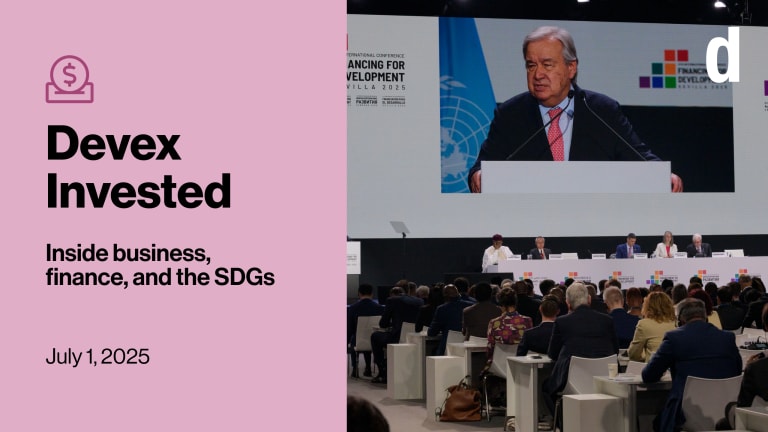
As the mounting crises surrounding Haiti’s earthquake and the U.S. pullout from Afghanistan unfold, I thought back to a piece I wrote five years ago from the World Humanitarian Summit: Where is the private sector in humanitarian response?
This is a preview of Devex Invested
Sign up to this weekly newsletter inside business, finance, and the SDGs, in your inbox every Tuesday.
It left me wondering just where things stand today, whether there’s been progress, and where the private sector or private capital might play a role in these and other crises.
• The Connecting Business Initiative was launched at that summit to improve coordination between the private sector and humanitarian and development actors. CBI has been working with its network in Haiti — the Alliance for Disaster Management and Business Continuity, known by the French abbreviation AGERCA — to improve the resilience of Haitian businesses and integrate them into the humanitarian response and recovery, Kareem Elbayar, program coordinator at CBI, tells me.
• In response to Saturday’s earthquake, AGERCA is providing the public and United Nations agencies with reports on the situation in Haiti, mapping what goods the private sector has and where they can be distributed while also coordinating with the U.N. and the national emergency response system.
• In addition to coordinating with multilateral and local leaders on the response, AGERCA is asking that humanitarian organizations prioritize local products made by Haitian companies. “Localization is really important,” Elbayar says, adding that the U.N. system needs to learn from the past by ensuring that spending stays in the country and that aid doesn’t distort the local economy.
• Beyond Haiti, while traditional collaboration and partnerships may be coming along, bringing private finance into these fragile contexts globally is further behind. The Humanitarian and Resilience Investing Initiative is connecting investors and the humanitarian community to design financing that can scale resilience projects and support humanitarian efforts. Among the challenges are data standards, projects that are too small to attract private capital and need to be bundled, and misaligned pitches, the World Economic Forum’s Andrej Kirn tells me.
• Still, since the launch of the HRI Initiative two years ago, there has been a “positive shift in mindsets and a clearer understanding of operating in such places,” Kirn says.
+ Catch up on Devex’s coverage of the crises in Haiti and Afghanistan.
Over the coal
The U.S. Treasury Department released new guidance Monday that asks multilateral development banks to oppose coal and oil projects and only support natural gas investments that meet certain criteria. MDBs should first look to invest in clean energy and energy efficiency investments, only considering fossil fuel investments when no other options are available, the agency said.
“Treasury’s Guidance supports poor and vulnerable countries, conflict-affected states, and small-island developing states in meeting their development goals while applying rigorous standards to reduce overall emissions and achieve the goals of the Paris Agreement,” the Treasury Department says. The U.S. is the largest shareholder across MDBs.
Doing the math
The International Monetary Fund’s issuance of Special Drawing Rights is expected later this month, so the conversation is heating up over how to reallocate them. In an opinion piece for Devex, global development professors Daniel Bradlow and Kevin Gallagher explore how to make SDRs work for lower-income countries.
Their recommendation: Use this moment to create a strategy for recycling SDRs. One thing that sticks with me is a lesson from history. When SDRs were created in 1969, lower-income countries advocated for a link to development so those most in need would get a larger share. Disagreement among supporters about how exactly that would work doomed the effort. Bradlow and Gallagher warn that history could repeat itself.
Wrong address
Your next job?
Senior Development Finance Analyst
Development Initiatives
Bristol, United Kingdom | Nairobi, Kenya
Not long ago, I wrote about how the International Finance Corporation, Proparco, DEG, and the U.S. International Development Finance Corporation invested in Aspen Pharmacare, a South African drug company, in an effort to “support the development of vaccines for African countries.” The investment is part of a major push by those institutions to boost manufacturing capacity on the continent.
The thing is, millions of COVID-19 vaccines manufactured by Aspen are heading to Europe rather than staying in Africa, according to former U.K. Prime Minister Gordon Brown. You can draw your own conclusions, but I have some questions for development finance institutions about whether the investments will achieve their stated goal.
What we’re reading
• BlackRock’s former head of sustainable investing calls environmental, social, and governance investing a “deadly distraction” that slows necessary reforms. [Financial Times]
• An oil company in Thailand is going big on investments in renewable energy in anticipation of future climate change regulations. [Bloomberg]
• A new report looks at the human rights impact of China’s investments. [Business & Human Rights Centre]
• Even African philanthropists are underfunding NGOs on the continent. [Devex]









